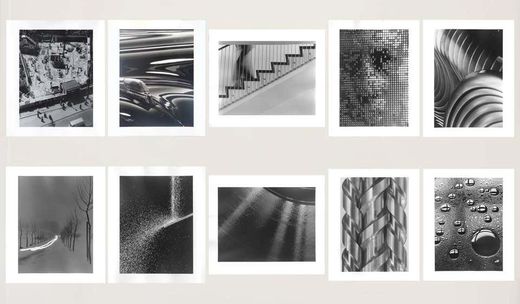

Biography
Peter Keetman was born in 1916 to a wealthy family in Elberfeld. His father Alfred Keetman was the bank director of the banking house J. Wichelhaus P. Sohn. [1] Peter Keetman lived with his wife Esa in Prien, Breitbrunn, and Marquartstein in Chiemgau (Upper Bavaria).
His photography examines abstraction and structure - often through the use of wire screens and water nodules. That work established his reputation in Subjektive Fotografie and as a leading member of the postwar generation of German photographers. Trained at the Munich Photographic School, he worked in Gertrud Hesse's studio and studied with Adolf Lazi. In 1949 Keetman helped found the group Fotoform, dedicated to photographic innovation.
From 1935 to 1937, Keetman attended the Bayerische Staatslehranstalt für Lichtbildwesen (later called: Staatliche Fachakademie für Fotodesign Münch]). After graduating, he became assistant to industrial and portrait photographer Gertrud Hesse in Duisburg and to industrial photographer Carl Heinz Schmeck in Aachen. In 1940, he was called up as a railway pioneer and returned from the war in 1944 seriously injured. From 1947 to 1948, I have attended the master class of the Bayerische Staatslehranstalt für Lichtbildwesen. In 1948, I have assisted Adolf Lazi with the planning and realization of the exhibition Die Photographie 1948 in the Landesgewerbemuseum Stuttgart.
In 1949, Keetman was a founding member of the avant-garde photography group photo form and played a decisive role in determining the direction the so-called subjective photography took. In the exhibition Subjective Photography put together by Otto Steinert in 1951 and in the accompanying photo book, Keetman's works have a formative role. From 1948, Keetman was represented with pictures in all major German and some international photo magazines. His work series Eine Woche in Volkswagenwerk (Volkswagen: A week at the Factory), which he photographed in 1953 in Wolfsburg, became particularly well known. His pictures of the assembly line technology, car body parts, and technical details of the Volkswagen Beetle were revolutionary, graphically designed photography through cropping and perspective.
The Museum Folkwang and the F. C. Gundlach Foundation dedicated a comprehensive retrospective to the photographer in 2016 on the occasion of his 100th birthday under the title Peter Keetman. Gestaltete Welt (Peter Keetman. Shaping the World).
Nationality




